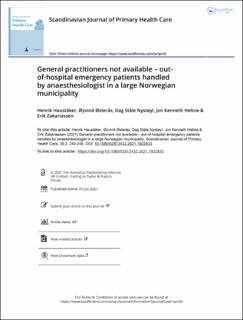| dc.contributor.author | Hauståker, Henrik | |
| dc.contributor.author | Østerås, Øyvind | |
| dc.contributor.author | Nystøyl, Dag Ståle | |
| dc.contributor.author | Heltne, Jon-Kenneth | |
| dc.contributor.author | Zakariassen, Erik | |
| dc.date.accessioned | 2022-03-21T09:13:39Z | |
| dc.date.available | 2022-03-21T09:13:39Z | |
| dc.date.created | 2022-01-07T12:56:09Z | |
| dc.date.issued | 2021 | |
| dc.identifier.citation | Scandinavian Journal of Primary Health Care. 2021, 39 (2), 240-246. | en_US |
| dc.identifier.issn | 0281-3432 | |
| dc.identifier.uri | https://hdl.handle.net/11250/2986362 | |
| dc.description.abstract | Background Until autumn 2018 the GPs in Bergen Municipality did not attend emergency patients outside the emergency primary care centre. The ambulance staff handled emergencies on their own or were assisted by an anaesthesiologist from the helicopter emergency medical service (HEMS). The aim of this study was to investigate procedures performed by the HEMS anaesthesiologist and to assess the level of skills needed to perform these procedures. Methods This study was a retrospective assessment of data from the period 2011 to 2013 on all emergency missions in which patients were dealt with by HEMS, using a rapid-response car in Bergen Municipality. All emergency missions were sorted into three categories: No intervention, Basic or Advanced intervention. This list was made by a research group with anaesthesiologists working for Bergen HEMS and GPs with OOH experience. The list is based on curriculum found in acute medicine courses. Results HEMS responded to 716 (2.3%) out of a total of 31,696 emergencies in Bergen Municipality during the three years. In more than two-thirds (71%) of these missions, no intervention or only a basic intervention was performed. Most advanced procedures were performed in patients with cardiac arrest. Conclusion By retrospective evaluation of HEMS missions by car in Bergen municipality, we found that nearly one-third of the patients received advanced procedures. Cardiac arrest was the medical condition in which the most advanced procedures were performed. More research is needed to evaluate procedures and the importance of clinical evaluation and physicians’ experience in treating these patient groups. KEY POINTS Both HEMS and on-call GPs are needed in emergency care, and more knowledge will be useful to highlight the level of practical skills needed in these missions. There is a need for better prioritization of when to use HEMS resources and when to use on-call GPs in emergency missions. More than two-thirds of the patients involved in emergency missions received no intervention or just a basic intervention when dealt with by HEMS. This raises the issue of whether an on-call GP could have adequately treated many of the patients in this study in terms of practical skills. | en_US |
| dc.language.iso | eng | en_US |
| dc.rights | Navngivelse 4.0 Internasjonal | * |
| dc.rights.uri | http://creativecommons.org/licenses/by/4.0/deed.no | * |
| dc.title | General practitioners not available – out-of-hospital emergency patients handled by anaesthesiologist in a large Norwegian municipality | en_US |
| dc.type | Peer reviewed | en_US |
| dc.type | Journal article | en_US |
| dc.rights.holder | © The Authors, 2021 | en_US |
| dc.description.version | publishedVersion | en_US |
| cristin.ispublished | true | |
| cristin.fulltext | original | |
| cristin.qualitycode | 1 | |
| dc.identifier.doi | 10.1080/02813432.2021.1922833 | |
| dc.identifier.cristin | 1976551 | |
| dc.source.journal | Scandinavian Journal of Primary Health Care | en_US |
| dc.source.volume | 39 | en_US |
| dc.source.issue | 2 | en_US |
| dc.source.pagenumber | 240-246 | en_US |

